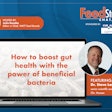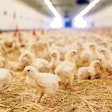As members of the feed and agriculture industry, we slightly cringe when restaurant servers describe their grass-fed, locally sourced beef as though the alternative should be avoided; we shudder when television cooking show hosts refer to “meatless Monday” as having an overwhelming impact on the environment; and we shake our heads in dismay when animal rights activists claim it takes more than 2,400 gallons of water to produce 1 pound of meat.
It’s not that we don’t support small farms or enjoy local meat. It’s not that we have no regard for environmental sustainability or oppose water conservation efforts — that couldn’t be further from the truth. In fact, the agriculture industry views environmental sustainability as one of its top concerns and many segments within it dedicate significant resources to improving their carbon footprints and finding better ways to produce more with less.
The problem is that negative perceptions of modern agriculture — specifically livestock production — largely stem from baseless claims and misleading reports, such as the 2006 United Nations Food and Agriculture Organization paper Livestock’s Long Shadow.
The report’s executive summary stated that livestock was responsible for 18% of the world’s total greenhouse gas emissions, more than the entire transportation sector combined. Because the comparison model the UN FAO used — called a lifecycle assessment — didn’t put transportation and livestock on an equal playing field, Dr. Frank Mitloehner, air quality specialist and associate professor of Animal Sciences at the University of California Davis, as well as other experts and academia in the food and agriculture industry, challenged the claim.
Then after Mitloehner et. al published a counter-report, Clearing the Air: Livestock’s Contribution to Climate Change, the UN FAO retracted its misleading conclusion and the 18% statement. Today the UN FAO is leading the “Partnership on the environmental benchmarking of livestock supply chains” to help improve the environmental performance of the livestock sector using accurate information from the industry itself.
Global partnership emerges
With participation on behalf of the American Feed Industry Association (AFIA), the International Feed Industry Federation (IFIF), the International Poultry Council (IPC), the International Meat Secretariat (IMS) and other global commodity organizations, the partnership is the largest of its kind and aims to create an agreed upon method by which to measure environmental impact and benchmark livestock production performance.
In 2011 the Institute for Feed Education and Research (IFEEDER), a 501(c)(3) charitable foundation whose mission is to sustain the future of food and feed production, approved a $15,000 donation to the AFIA to support a broad cross section of agriculture professionals who bring a balanced scientific view to the partnership and could help determine the proper lifecycle assessment for the study.
Along with several other feed industry experts, AFIA asked Mitloehner to represent it at the partnership’s steering committee in Rome, Italy, last summer where he was elected chairman for the first year of the three-year initiative.
“It’s an extremely important project for the industry, both in the United States and globally,” says Joel Newman, president and CEO of AFIA. “We’re very pleased that IFEEDER was able to support it and allow us to be a major contributor in the process and for [Dr. Mitloehner] to have the honor to chair this first year of the project.”
Not even a full year into the partnership, Mitloehner says progress is well underway.
“Three technical advisory groups have been formed with experts throughout the world: small ruminants, feed sector and poultry sector,” says Mitloehner. “These three groups are in the midst of establishing the methodology of developing environmental footprints for each industry.”
By the end of the first year the three groups will have a report and in the second year the groups on beef and swine will form and finish their respective reports.
Far-reaching affect
Although the partnership was spurred partly by the UN FAO’s acknowledgement of incorrect statements regarding livestock production, its outcome will reach far beyond simply righting a wrong.
Newman explains how AFIA will use the partnership’s findings to share better decision-influencing information with its members going forward.
“Part of our individual objective is to develop a database for the carbon footprint of the major processed feed ingredients we use in feed manufacturing,” Newman says. “That information will help our members make sure they’re doing their best to minimize the impact on the environment through feeding livestock and poultry.”
IFEEDER board member Bruce Crutcher, president of Truow Nutrition, says the feed industry is eager to learn how it can improve its environmental footprint.
“We all know environmental stewardship has room for growth,” says Crutcher. “Being able to measure where you have been, where you currently are and the impact of the changes you make going forward will be very valuable.”
Why is change needed?
The root of production agriculture’s need to benchmark its environmental impact is the fact the population is on a steep upward trajectory. By the year 2050, it’s estimated there will be a total of 9.1 billion people to feed worldwide.
“We have to double [global food output], but we can’t just double herd sizes, we have to get more product out of existing herds or shrinking herds,” says Mitloehner. “We’ve shown that’s possible in the United States where we’ve doubled our beef production with half the number of animals in the last 40 years, but we need to do the same thing all over the world.
“The obstacle is that many in the United States feel that we we’ve gone beyond the point of optimization and we’re now exploiting animals and the environment.”
Increasing the world’s food supply is an inevitable reality that can’t be achieved without the commercial feed and livestock sectors. Through the UN FAO’s environmental benchmarking of livestock partnership, IFEEDER and other agriculture organizations are helping find better ways to measure the industry’s impact and make the improvements necessary to sustainably feed the world for generations to come.
To learn more about IFEEDER’s mission, visit www.ifeeder.org.



















